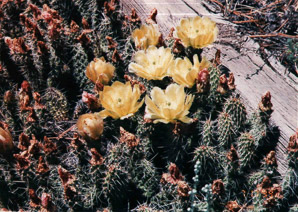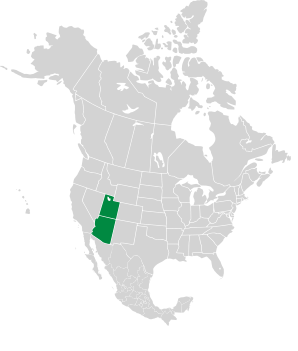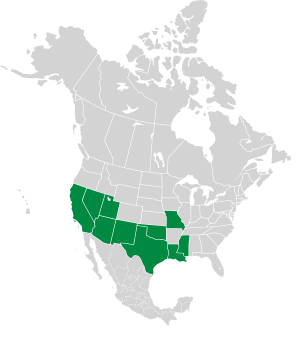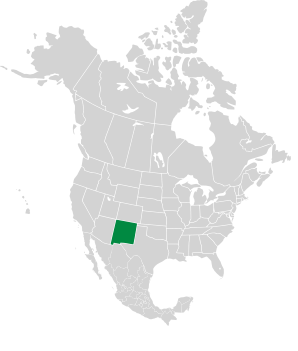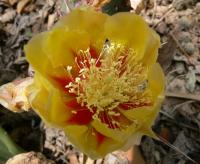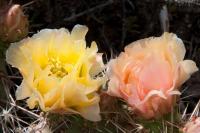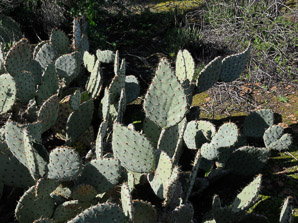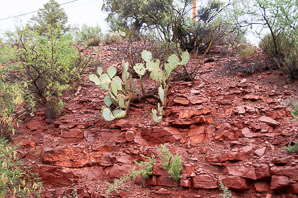
|
Opuntia Mill. Prickly pear cactus, prickly pear, cholla
The large genus Opuntia includes prickly pear and beavertail cacti, both of which have stems that resemble paddles, many oval pads ½-1″ (1.3-2.5 cm) thick. Cholla used to be considered Opuntia as well, but they have been reclassified as members of Cylindropuntia. Botanists disagree as to whether Cylindropuntia should be a separate genus or a subgenus of Opuntia. This table compares some members of Opuntia. |
(Opuntia) · 7/11/1999 · Florissant and Lake George area, Colorado · By Tim Chandler |
|||||||||||||||||||||||||
|
| ||||||||||||||||||||||||||
Opuntia aurea |
Opuntia engelmannii |
Opuntia engelmannii var. cuija |
||||||||||||||||||||||||
|---|---|---|---|---|---|---|---|---|---|---|---|---|---|---|---|---|---|---|---|---|---|---|---|---|---|---|
| Common Name |  |
 |
 |
|||||||||||||||||||||||
| Plant | These plants are 4-12″ (10-30 cm) high, lying or growing close to the ground. | Up to 6′ (1.8 m) high, usually lower; in spreading clumps up to 10′ (3 m) wide. | Up to 8′ (2.4 m) high, usually lower; in spreading clumps up to 10′ (3 m) wide. | |||||||||||||||||||||||
| Flowers | Yellow or pink, 1¾-3″ (5-7.5 cm) in size. | Yellow to red. | Yellow to red. About 2-3″ (5-7.6 cm) across. | |||||||||||||||||||||||
| Leaves | Glochids are tan or brown, ⅛″ (3 mm) long. There are no spines unless it has introgressed with other species. | Spines are 1-1½″ (2.5-3.8 cm) long, in groups of 1-6, groups about 1½″ (3.8 cm) apart. No spines or very short spines, spines are chalky white, sometimes yellow. | Spines are 1-1½″ (2.5-3.8 cm) long, in groups of 2-6 (usually 3-5), groups about 1½″ (3.8 cm) apart. No spines or very short spines, spines are light yellow. | |||||||||||||||||||||||
| Stem | Stem segments are ellipse- or egg-shaped, 1¾-4″ (5-10 cm) × 1-2″ (3-6 cm). | Thick yellowish- or bluish-green pads up to 10″ (25 cm) long, less than 1" thick. | Thick yellowish- or bluish-green pads up to 10″ (25 cm) long, less than 1" thick. | |||||||||||||||||||||||
| Fruit | ½-⅞″ (1.5-2.5 cm) in diameter, green, without spines. | Barrel-shaped, initially yellow-green, ripening to purple, up to 3″ (7.6 cm) long. No spines or very short spines, spines are chalky white, sometimes yellow. | Barrel-shaped, initially yellow-green, ripening to purple, up to 3″ (7.6 cm) long. | |||||||||||||||||||||||
| Range/ Zones |
|
|
|
|||||||||||||||||||||||
| Habitats | Pinyon-juniper woodlands and red sands | Desert scrub, grasslands, oak/pine/juniper woodlands | Desert scrub, grasslands, oak/pine/juniper woodlands | |||||||||||||||||||||||
| Type | Wild | Wild | Wild | |||||||||||||||||||||||
| Occurrence | Common | |||||||||||||||||||||||||
Opuntia laevis
Opuntia macrocentra
Opuntia phaeacantha



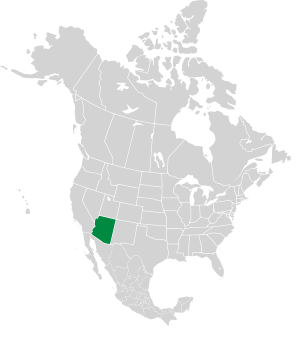
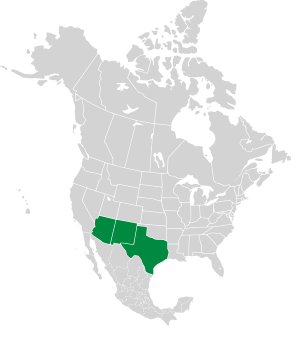
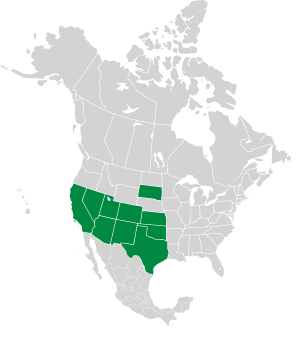
Opuntia santa-rita


Online References:
Wikipedia (Opuntia)
PlantSystematics.org (Opuntia)
Desert-tropicals.com (Opuntia)
The Arizona-Sonora Desert Museum Center for Sonoran Desert Studies
References:
Opuntia description by Thomas H. Kent, last updated 16 Sep 2020.
© FloraFinder.org. All rights reserved.
(Opuntia) · 2/24/2010 · San Diego (Quail) Botanic Garden, Encinitas, California ![]() Species not yet identified
Species not yet identified 
Prickly pear cactus (Opuntia) · 5/22/2009 · Red Rock Loop, Arizona ![]() Species not yet identified
Species not yet identified 
Range:

